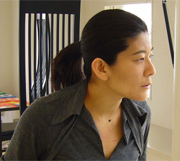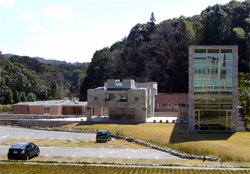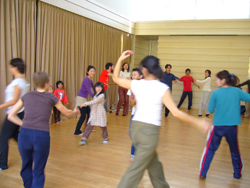

Machiko Harada, Curator, Akiyoshidai International Art Village
Yosuke Kawamura, and Mika Fukumori
Institute of Advanced Media Arts and Sciences (IAMAS)
Interviewer: Sachiko Kanno, the Japan Foundation; Akemi Tsukada, NLI Research Institute
The Akiyoshidai International Art Village(Shuho-cho, Yamaguchi Prefecture), established in 1998, is a public cultural institution to support creative activities through the residency program with an aim to serve as a place to create and promote arts and culture toward the world. IAMAS(Institute of Advanced Media Arts and Sciences + International Academy of Media Arts and Sciences, Ogaki, Gifu Prefecture) is a university renowned in the field of media art and has been carrying out the artist-in-residence program for media artists since 1996.
Both institutions have been running well acknowledged artist-in-residence programs for over ten years. Machiko Harada of Akiyoshidai International Art Village and Yosuke Kawamura and Mika Fukumori of IAMAS spoke about the current situation and future direction of their programs.
(* Refer to AIR-JAPAN Database for the details of these programs)
Overview of the residency programs
──Could you explain what the residency program at Akiyoshidai International Art Village (AIAV) offers?
Harada──AIAV currently runs two residency programs: the Residence Support Program and the Residence Fellow Program. The Residence Support Program invites artists for the residence of about two and a half months through open call. Program provisions such as traveling expense, living expense, production fee, and accommodation are offered. Professional support for production and publicity is also provided. We have Heini Nukari (Finland / dancer), Loic Sturani (Italy / visual artist), and Marina Fraga (Brazil / visual artist) in residence now (as of March 2007).
The Residence Fellow Program is open for not only artists but also researchers who are able to obtain traveling expense and project support from the artist-in-residence network, other cultural institutions or foundations, or research institutions. Under this Fellow Program, we also invite artists who took up residency at AIAV in the past once again for a period of a week to a month. We provide accommodation and studio including facilities and equipment. Fellows are asked to carry out public programs during or after their residency, and the expense for such activities is covered by AIAV. Artists who participate in this Fellow Program are those who have been established or highly promising in their future career or those who have already stayed and worked at AIAV. So they bring detailed plans to AIAV they have developed in advance, and they are highly motivated in realizing their own projects. We also find advantage in growing the number of artists who have ties with Yamaguchi Prefecture to bring information to local communities and artists.
On the other hand, most of the artists who join the Support Program are young and have never come to Japan before. They are looking for new ideas and inspiration in a new environment and their initial plans are always changing throughout their residency period.

Machiko Harada, Curator, Akiyoshidai International Art Village
──How about the residency program at IAMAS?
Fukumori───IAMAS runs the residency program for media artists. This program is funded by Gifu Prefecture as our institution is a prefectural university of Gifu. The artist-in-residence program has been expected to bring influence and inspiration to the students of IAMAS since its inauguration and we invited established artists during the earlier phase.
The application for our residency program through open call has been widely known among artists lately and more and more young artists take up residency at IAMAS. We provide living expense which includes production fee and accommodation as well as return tickets as traveling expense.

Accommodation Building, Akiyoshidai International Art Village
Screening schedule and criteria
Harada──AIAV distribute application forms for open call from early April to the end of May. The deadline falls by the end of summer. The selection is finalized and announced in fall. The artists start their residency in January.
The screening involves two stages. First, curators in charge of the residence program narrow the list of the applicants. It is fairly easy to judge their motivation to come to AIAV by reading their application forms. In 2006, we narrowed 300 applicants down to around 5% at this stage. We thoroughly research these artists for the second stage where we organize the selection committee comprising external members. At the second screening, curators give the presentation about each artist on the shortlist and the selection committee makes the final selection.
We put the contents of the application forms into data to make sure information of all the applicants is ready if committee members are interested in artists who are not on the shortlist.
Fukumori──We received applications from thirty groups for 2007. Lecturers of IAMAS are nominated to screen applicants in their specific genre. The selection committee ranks the applicants and narrows the list to top three groups. Committee finalizes the selection and the faculty committee approves the decision. The resident artists are accepted by lecturers whose specialty is close to theirs or who share interest with them.
──What are the criteria for selecting artists?
Harada──Since 2006, we have been choosing artists based on their interest and actual plans for exchange programs with local residents. Applicants are requested to explain their proposals about community programs in the application form. We examine the artists?f attitude toward community engagement and feasibility of their plans by reading their proposals. Artists will learn a lot from community activities, however we try not to overemphasize communication in their experience at AIAV.
Fukumori──IAMAS places more importance on artists?f interaction with the students of IAMAS than local residents. The resident artists are requested to give a three-hour session of presentation about their work or workshop at the beginning of their residency. The students are encouraged to get involved in the artists?f activities when such needs for cooperation are raised.
──AIAV attracts more and more performing artists these years.
Harada──Yes indeed. Artists of highly diverse genres and nationalities are applying for our residency. 2006 saw a leap in applications from Ireland and Poland. As for Irish applicants, it seems they obtained information on AIAV through the residence program of the Irish Museum of Modern Art.
Cooperation with local art centers
──How do you work with local art centers?
Harada──Cooperation with YCAM ?iYamaguchi Center for Arts and Media?j has been going very well as it was requested by the prefectural government when YCAM was established. We have done several collaborative projects so far. For example, ?gStudy of Live works BANETO?h stayed at AIAV for a month and performed a new piece at YCAM. Also, Tomoko Mukaiyama held two different concerts at YCAM and AIAV.
YCAM has much better access as it is located in the center of Yamaguchi City. Their facilities are excellent and the number of professional staff is much larger. Considering such conditions, YCAM should be very attractive for artists. Of course, we too have to make an effort to bring more and more people to AIAV.
──Nature and architecture of AIAV would be inspiring for artists, wouldn?ft they?
Harada──Yes indeed. In January 2007, we accepted ?gDance X Music?h organized by JCDN (NPO Japan Contemporary Dance Network). This is a program of choreographer and musician to create a new work of contemporary dance collaboratively. They were interested in working on this project at AIAV as it could offer a desirable environment where they could concentrate on production. They took up a short-term residency here and held a performance. YCAM kindly offered a rehearsal studio to them.
Relations with community and program assessment
──How do you think the artist-in-residence programs in Japan are changing?
Harada──I think it is apparent that residencies run by public organizations focus on their relations with local communities. Workshops and other programs aiming to directly contribute to communities are growing rapidly.
As organizer, we try to develop programs for local residents but at the same time we also keep discussing how to provide artists with an environment suitable to nurture their creativity. As the residence program is an occasion for local residents to experience art, I hope we could build mutual relations through learning together.
Residencies could not receive as huge crowd of audience as performances and festivals could. Alternatively, residencies could offer more intense artistic experience than just listening or watching, through direct communication with artists. This cannot be appreciated without experiencing it, which is also a reason why residence programs are often said to be difficult to understand. But I believe exchange with artists will serve as a good chance for the audience to see their production process and learn their perspectives and ideas. We are trying to widen such opportunities for local residents but we find it hard to bring ourselves close enough to them as AIAV is located far from the city center.

Work shop: trans2007
Fukumori──IAMAS is actually scaling down the program. We used to invite two groups per year to stay for six months each but from 2006 we accept a group only for half a year. We are discussing the possibility of a short-term residency for a month each to emphasize the importance of the residence program in an academic institution.
Also, we are considering another short residency to fill the vacant period of the accommodation which we rent throughout the year. In this case, we do not support living expense but provide studio in the campus and accommodation.
──Assessment of cultural policies and institutions is required today, which more or less means restructure or curtailment of such projects. It should be hard to prove the true value of artist-in-residence programs as it could not be assessed numerically. But, for that very reason, all those who work in this field need to discuss strategies for sustainable management of the residence programs.
Harada──In Japan or anywhere, more artists nowadays prefer visiting the site and doing research there when they are going to make artworks for exhibitions or art projects. But it would be difficult for those who are not really used to seeing art to grasp the artists?f intentions and whole working process by just looking at their finished products. Artists and curators alike would need to think more about how to show works and how to approach to the audience.
Potentials and future of the artist-in-residencies
──How will the experience at the residence program benefit artists?
Harada──Heini from Finland, for example, seems to be very happy about this remote environment as she can concentrate on production. Time and environment for work and contemplation is what AIAV could offer to artists. But to achieve fruitful outcome from their residency, we have to direct their interest and plans by providing them with adequate information and advice. Artists who come here for the first time have no idea about resources available here. If they tell us what kind of person they want to meet or what kind of materials they want to use, we can help them develop their projects by sourcing together.
──It would be important to design the program structure carefully so that environment and support host organizations could offer would meet artists?f needs for their production. AIAV enjoys beautiful nature and Scandinavian artists find it very comfortable here. Artists who work in relation to nature to create earth works, for example, would be highly benefited from this environment. Interest and background of each artist are influential factors for his/her experience at AIAV, which will reveal local cultural resources that have not been noticed before.
Harada──Possibilities would be widened if we could accept a large number of artists. I?fve heard cultural or art institutions and organizations abroad make arrangements with one another to encourage exchange of artists among them.
──Japan should have network with institutions overseas and build interface to supply information on artist-in-residence programs at home and abroad. The number of foreign artists who wish to work in Japan is increasing rapidly. System or manual would need to be developed to receive artists who have obtained funds or fellowships for themselves. Then chance for artists to stay and work in Japan will be more open. AIAV and IAMAS are examples of institutions complete with facilities and professional support. If artists can stay at such renowned institutions all the year round, the residencies will become a source of inspiration and creativity for artists and local residents alike. Thank you very much.
[March 10, 2007 at Akiyoshidai International Art Village]
2024.7.9Acasă la Hundorf Residency JournalArtist : Miyake Suzuko
2023.5.14AIR and I, 09 : Mentoring Artists for Women’s Art (MAWA) Residence Report